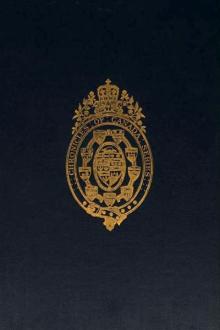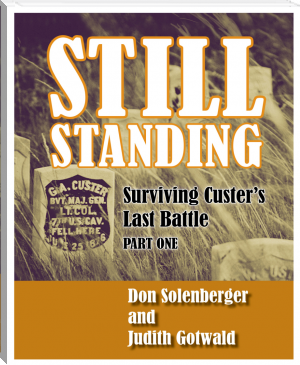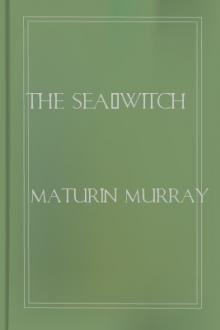The Mariner of St Malo by Stephen Leacock (early readers .TXT) 📕

- Author: Stephen Leacock
- Performer: -
Book online «The Mariner of St Malo by Stephen Leacock (early readers .TXT) 📕». Author Stephen Leacock
Roberval could keep his colonists in subjection only by the use of irons and by the application of the lash. The gibbet, reared beside the fort, claimed its toll of their number.
The winter of their misery drew slowly to its close. The ice of the river began to break in April. On June 5, 1543, their leader, Roberval, embarked on an expedition to explore the Saguenay, ‘leaving thirty persons behind in the fort, with orders that if Roberval had not returned by the first of July, they were to depart for France.’
Whither he went and what he found we do not know. We read that on June 14. certain of his company came back with messages to the fort: that five days later still others came back with instructions that the company at the fort were to delay their departure for France until July 19.
And here the narrative of the colony breaks off.
Of Roberval’s subsequent fate we can learn hardly anything.
There is some evidence to show that Cartier was dispatched from France to Canada to bring him back. Certain it is that in April 1544 orders were issued for the summons of both Cartier and Roberval to appear before a commission for the settling of their accounts. The report of the royal auditors credits Cartier apparently with a service of eight months spent in returning to Canada to bring Roberval home. On the strength of this, it is thought likely that Cartier, returning safely to France in the summer of 1542, was sent back again at the king’s command to aid in the return of the colonists, whose enterprise was recognized as a failure. After this, Roberval is lost to sight in the history of France. Certain chroniclers have said that he made another voyage to the New World and perished at sea. Others have it that he was assassinated in Paris near the church of the Holy Innocents. But nothing is known.
Cartier also is practically lost from sight during the last fifteen years of his life. His name appears at intervals in the local records, notably on the register of baptisms as a godfather. As far as can be judged, he spent the remainder of his days in comfortable retirement in his native town of St Malo. Besides his house in the seaport he had a country residence some miles distant at Limoilou. This old house of solid and substantial stone, with a courtyard and stone walls surrounding it, is still standing. There can be no doubt that the famous pilot enjoyed during his closing years a universal esteem. It is just possible that in recognition of his services he was elevated in rank by the king of France, for in certain records of St Malo in 1549, he is spoken of as the Sieur de Limoilou. But this may have been merely the sort of courtesy title often given in those days to the proprietors of small landed estates.
It was sometimes the custom of the officials of the port of St Malo to mark down in the records of the day the death of any townsman of especial note. Such an entry as this is the last record of the great pilot. In the margins of certain documents of September 1, 1557, there is written in the quaint, almost unreadable penmanship of the time: ‘This said Wednesday about five in the morning died Jacques Cartier.’
There is no need to enlarge upon the greatness of Cartier’s achievements. It was only the beginning of a far-reaching work, the completion of which fell to other hands. But it is Cartier’s proud place in history to bear the title of discoverer of a country whose annals were later to be illumined by the exploits of a Champlain and a La Salle, and the martyrdom of a Brebeuf; which was to witness, for more than half a century, a conflict in arms between Great Britain and France, and from that conflict to draw the finest pages of its history and the noblest inspiration of its future; a country upon whose soil, majestic in its expanse of river, lake, and forest, was to be reared a commonwealth built upon the union and harmony of the two great races who had fought for its dominion.
Jacques Cartier, as much perhaps as any man of his time, embodied in himself what was highest in the spirit of his age. He shows us the daring of the adventurer with nothing of the dark cruelty by which such daring was often disfigured. He brought to his task the simple faith of the Christian whose devout fear of God renders him fearless of the perils of sea and storm. The darkest hour of his adversity in that grim winter at Stadacona found him still undismayed. He came to these coasts to find a pathway to the empire of the East. He found instead a country vast and beautiful beyond his dreams. The enthusiasm of it entered into his soul. Asia was forgotten before the reality of Canada. Since Cartier’s day four centuries of history have hallowed the soil of Canada with memories and associations never to be forgotten. But patriotism can find no finer example than the instinctive admiration and love called forth in the heart of Jacques Cartier by the majestic beauty of the land of which he was the discoverer.
ITINERARY OF CARTIER’S VOYAGES
Adapted from Baxter’s ‘Memoir of Jacques Cartier’
VOYAGE OF 1534
April 20 Monday Cartier leaves St Malo.
May 10 Sunday Arrives at Bonavista.
” 21 Thursday Reaches Isle of Birds.
” 24 Sunday Enters the harbour of Kirpon.
June 9 Tuesday Leaves Kirpon.
” 10 Wednesday Enters the harbour of Brest.
” 11 Thursday St Barnabas Day. Hears Mass and explores coast in boats.
” 12 Friday Names St Anthoine, Servan; plants cross and names river St Jacques, and harbour Jacques Cartier.
” 13 Saturday Returns to ships.
” 14 Sunday Hears Mass.
” 15 Monday Sails toward north coast of Newfoundland.
” 16 Tuesday Follows the west coast of Newfoundland and names the Monts des Granches.
June 17 Wednesday Names the Colombiers, Bay St Julien, and Capes Royal and Milk.
” 18 Thursday Stormy weather to 24th; explores coast between Capes Royal and Milk.
” 24 Wednesday Festival of St John the Baptist. Names Cape St John.
” 25 Thursday Weather bad; sails toward the west and and south-west; discovers Isles Margaux, Brion, and ” 26 Friday Cape Dauphin.
” 27 Saturday Coasts toward west-south-west.
” 28 Sunday Reaches Cape Rouge.
” 29 Monday Festival of St Peter. Names Alezay and Cape St Peter, and continues course west-south-west.
” 30 Tuesday Towards evening describes land appearing like two islands.
July 1 Wednesday Names Capes Orleans and Savages.
” 2 Thursday Names Bay St Leonarius.
” 3 Friday Continues northerly course and names Cape Hope.
” 4 Saturday Arrives at Port Daniel; remains there until 12th.
July 16 Thursday Enters Gaspe Bay, and remains until 25th on account of storm.
” 22 Wednesday Lands and meets savages.
” 24 Friday Plants a cross.
” 25 Saturday Sets sail with good wind toward Anticosti.
” 27 Monday Approaches coast.
” 28 Tuesday Names Cape St Louis.
” 29 Wednesday Names Cape Montmorency and doubles East Cape of Anticosti.
Aug. 1 Saturday Sights northern shore of the Gulf of St Lawrence.
” 8 Saturday Approaches west coast of Newfoundland.
” 9 Sunday Arrives at Blanc Sablon, and makes preparations to return home.
” 15 Saturday Festival of the Assumption. Hears Mass and sets sail for France.
Sept. 5 Saturday Arrives at St Malo.
SECOND VOYAGE, 1535
May 16 Sunday First Pentecost. The crew commune at Cathedral and receive Episcopal Benediction.
” 19 Wednesday Departure from St Malo.
” 26 Wednesday Contrary winds.
June 25 Friday Ships separated by storm.
July 7 Wednesday Cartier reaches the Isle of Birds.
” 8 Thursday Enters Strait of Belle Isle.
” 15 Thursday Reaches the rendezvous at Blanc Sablon.
” 26 Monday Ships meet.
” 29 Thursday Follows north coast and names Isles St William.
” 30 Friday Names Isles St Marthy.
” 31 Saturday Names Cape St Germain.
Aug. 1 Sunday Contrary winds; enters St Nicholas Harbour.
” 8 Sunday Sails toward the southern coast.
” 9 Monday Contrary wind; turns toward north and stops in Bay St Lawrence.
” 13 Friday Leaves Bay St Lawrence, approaches Anticosti, and doubles the western point.
” 15 Sunday Festival of the Assumption. Names Anticosti, Isle of the Assumption.
” 16 Monday Continues along coast.
” 17 Tuesday Turns toward the north.
” 19 Thursday Arrives at the Seven Islands.
” 20 Friday Ranges coast with his boats.
” 21 Saturday Sails west, but obliged to return to the Seven Islands owing to head winds.
Aug. 24 Tuesday Leaves the Seven Islands and sets sail toward south.
” 29 Sunday Martyrdom of St John Baptist. Reaches harbour of Isles St John.
Sept. 1 Wednesday Quits the harbour and directs his course toward the Saguenay.
” 2 Thursday Leaves the Saguenay and reaches the Bic Islands.
” 6 Monday Arrives at Isle-aux-Coudres.
” 7 Tuesday Reaches Island of Orleans.
” 9 Thursday Donnacona visits Cartier.
” 13 Monday Sails toward the River St Charles.
” 14 Tuesday Exaltation of the Holy Cross. Reaches entrance of St Charles River.
” 15 Wednesday Plants buoys to guide his ships.
” 16 Thursday Two ships are laid up for the winter.
” 17 Friday Donnacona tries to dissuade Cartier from going to Hochelaga.
” 18 Saturday Donnacona’s stratagem to deter Cartier from going to Stadacona.
” 19 Sunday Cartier starts for Hochelaga with his pinnace and two boats.
Sept. 28 Tuesday Enters Lake St Peter.
” 29 Wednesday Leaves his pinnace, and proceeds with his boats.
Oct. 2 Saturday Arrives at Hochelaga.
” 3 Sunday Lands and visits town and mountain, which he named Mount Royal, and leaves Sunday.
” 4 Monday Regains his pinnace.
” 5 Tuesday Takes his way back to Stadacona.
” 7 Thursday Stops at Three Rivers, and plants cross upon an island.
” 11 Monday Arrives at the anchorage beside Stadacona.
” 12 Tuesday Donnacona visits Cartier.
” 13 Wednesday Cartier and some of his men visit Stadacona.
1536
April 16 Sunday Easter Sunday. The river clear of ice.
” 22 Saturday Donnacona visits Cartier with large number of savages.
” 28 Friday Cartier sends Guyot to Stadacona.
May 3 Wednesday Festival of the Holy Cross. A cross planted; Cartier seizes Donnacona.
May 5 Friday The people of Stadacona, bring provisions for Cartier’s captives.
” 6 Saturday Cartier sails.
” 7 Sunday Arrives at Isle-aux-Coudres.
” 15 Monday Exchanges presents with the savages.
” 22 Monday Reaches Isle Brion.
” 25 Thursday Festival of the Ascension. Reaches a low, sandy island.
” 26 Friday Returns to Isle Brion.
June 1 Thursday Names Capes Lorraine and St Paul.
” 4 Sunday Fourth of Pentecost. Names harbour of St Esprit.
” 6 Tuesday Departs from the harbour of St Esprit.
” 11 Sunday St Barnabas Day. At Isles St Pierre.
” 16 Friday Departs from Isles St Pierre and makes harbour at Rougenouse.
” 19 Monday Leaves Rougenouse and sails for home.
July 6 Friday Reaches St Malo.
THIRD VOYAGE, 1541
May 23 Monday Cartier leaves St Malo with five ships.
Aug. 23 Tuesday Arrives before Stadacona.
” 25 Thursday Lands artillery.
Sept. 2 Friday Sends two of his ships home.
” 7 Wednesday Sets out for Hochelaga.
” 11 Sunday Arrives at Lachine Rapids.
(The rest of the voyage is unknown.)
BIBLIOGRAPHICAL NOTE
A Great





Comments (0)